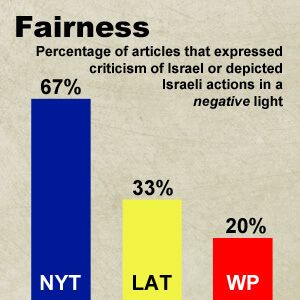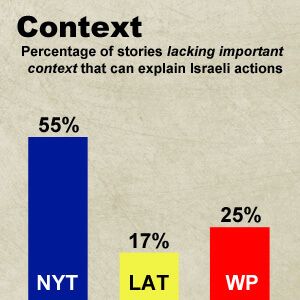For many years, we have published in-depth analyses that show the consistent and pervasive anti-Israel bias of the New York Times. Check out the reports here, here, and here. We even awarded the NY Times our “Dishonest Reporter” award for the most biased reporting of 2013.
We have documented how the vast majority of articles and editorials in the NY Times depict Israel in an unfavorable and often erroneous way. Yet the NY Times might argue that its coverage is negative because Israel’s actions and policies warrant such coverage. In other words, it would claim to be simply reporting the news rather than presenting a biased viewpoint.
So we decided to compare the NY Times’ coverage to that of the Washington Post and Los Angeles Times. If coverage of Israel by all three papers was close, then perhaps the NY Times’ argument would have merit.
On the other hand, if the NY Times presented a different picture of Israel than the other papers, it would add to the evidence that it reports from a biased, anti-Israel perspective. How else could one explain that the NY Times covers Israel differently to other sources reporting on the same events?
So what did we find?
In every category we measured, the coverage of Israel by the New York Times was far worse than that of the LA Times and Washington Post. Again, this is analyzing coverage of the same events in the same time period (January-February 2014.) We looked at four categories of bias: Fairness, Context, Terminology, and Selection of Sources. Some of the bias is very subtle, but when readers absorb news that is written in a bias way, it can’t help but impact the way they understand events.
Just one example paints the picture. We looked at what we refer to as “fairness.” By that, we mean what percentage of the articles concerned subjects that reflected negatively on Israel.
While only one quarter of the Washington Post articles and one third of those in the LA Times reflected negatively on Israel, an overwhelming 67% of articles in the New York Times did so.
Other metrics we measured showed similar discrepancies.
Findings Explained:
Fairness:
Percentage of articles that expressed criticism of Israel or depicted Israeli actions in a negative light.
 (Note: The Washington Post also published stories from the Associated Press that tend to provide a more negative view of Israel. They are not included in this study. We used only articles from the Post’s own reporters.)
(Note: The Washington Post also published stories from the Associated Press that tend to provide a more negative view of Israel. They are not included in this study. We used only articles from the Post’s own reporters.)
In any media outlet’s reports on Israel, there will be some negative and critical stories. That’s to be expected since Israel, like all Western countries, is not perfect. However, there is no reason why negative stories should overwhelm all other coverage. They don’t in the LA Times or the Washington Post. Yet reporting on the same facts and the same events, the New York Times finds a way to report negatively on Israel two-thirds of the time.
For example, on January 10, the New York Times published “In Blow to Peace Efforts, Israel Publishes Plans for New Housing in Settlements.” Not only is the Israeli announcement labeled a “Blow to Peace Efforts” in the headline, but the article opens by referring to “a move the chief Palestinian negotiator condemned as a “slap” to Secretary of State John Kerry’s intense push for a Middle East peace deal.” Before the reader can actually get to the details, the Israeli announcement has been qualified in both the headline and the first paragraph.
The same day, the LA Times published an article on the same issue with the headline simply stating that “Israel announces more settlement construction.” The article opens and describes how the move drew criticism but was expected. The Washington Post had a similarly neutral headline. The Post did mention the “slap” reference, but only in the fifth paragraph. It is only the New York Times that elevates the quotation by Saeb Erekat to the first description of the Israeli policy. The way the NY Times reported on the Israeli announcement was far from an objective survey of the facts – it condemned Israel by using an opinion on settlements as a factual analysis.
Then there is the issue of opinion pieces. In the New York Times, 88% of the op-eds were critical of Israel. Most of the opinion pieces in the LA Times and Washington Post were either neutral or positive. Examples of opinion pieces critical of Israel or Israeli actions or leaders include “Israel Needs to Learn Some Manners,” “How Israel is Losing the Propaganda War,” and “The Third Intifada” (justifying the boycott movement.) The NY Times employs regular columnists like Tom Friedman who has shown a history of one-sided criticism of Israel and support for the Palestinian Authority.
Context:
Percentage of stories lacking important context that can explain Israeli actions.
The situation in the Middle East is complicated. When important context is left out, readers can get a biased view of what’s happening and what Israel is doing. In an article that mentions Jerusalem, stating “which Israel conquered in 1967″ is not enough. This neglects to mention the city’s thousands of years of Jewish history or any context to the 1967 war – a war of defense that ended with Israel in control of Jerusalem. Implying that Israel is a “conqueror” lacks such context.
Settlements should not simply be labeled as “illegal under international law” without the acknowledgement that there is a wide range of opinion on this issue.
Likewise, in reporting on the Palestinian education system, to neglect to mention the specific, documented cases of anti-Israel incitement and glorification of terrorists in Palestinian schools would be to leave out critical context. Some Palestinian schools are even named after terrorists and there are murals honoring terror that Palestinian children are exposed to every day.
Yet, in “For Arabs in Israel, Curriculum Choice is Politically Charged,” the NY Times glosses over this information and instead uses quotations from Arabs stating how important it is to them that the Palestinian “narrative” be taught in school. They turn the story of Israeli funding for schools to use a standard curriculum into a conspiracy. One person interviewed says:
“I don’t want my son to be afraid to say he’s Palestinian.”
Another Palestinian says:
“The Israeli authorities “don’t only want to occupy the land, they want to occupy the minds of the people — like a brainwashing.”
There is no way that readers will be able to understand the curriculum debate when presented only with these types of opinion without reference to the history of anti-Israel incitement in Palestinian schools.
In “Abbas, Talking to Israeli Students About Peace, Finds a Receptive Audience,” Mahmoud Abbas is treated as a moderate leader willing to make serious compromises in the name of peace. While it has been well documented that Abbas has made fiery speeches in Arabic that contradict the image the NY Times paints, the article simply notes:
Batting away accusations by some Israelis that he says one thing in Arabic and another in English, Mr. Abbas said, “I speak the same language with everyone.” (Mr. Abbas addressed the students in Arabic; simultaneous translations in Hebrew and English were provided.)
But that statement has been proven to be false time and again. Why should the NY Times allow it to stand unchallenged?


